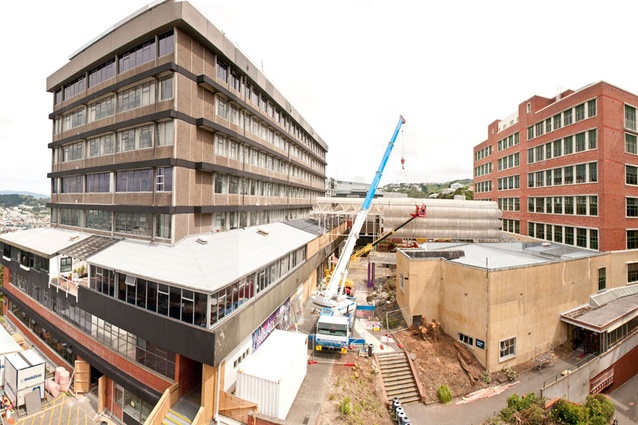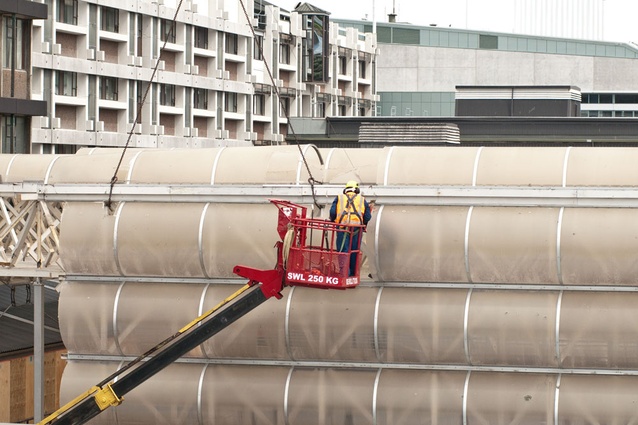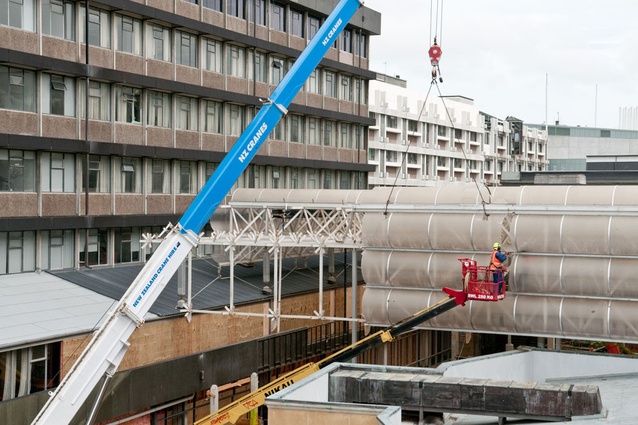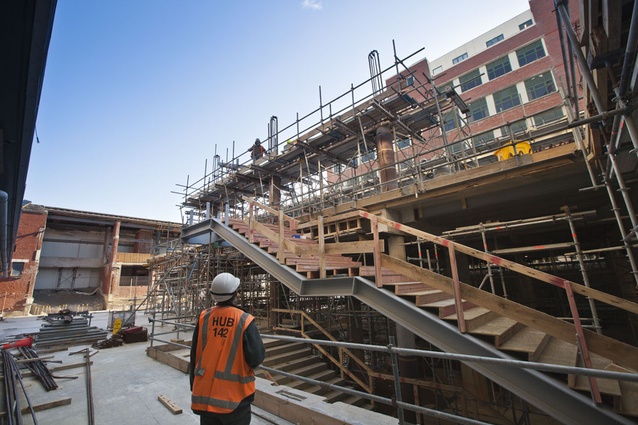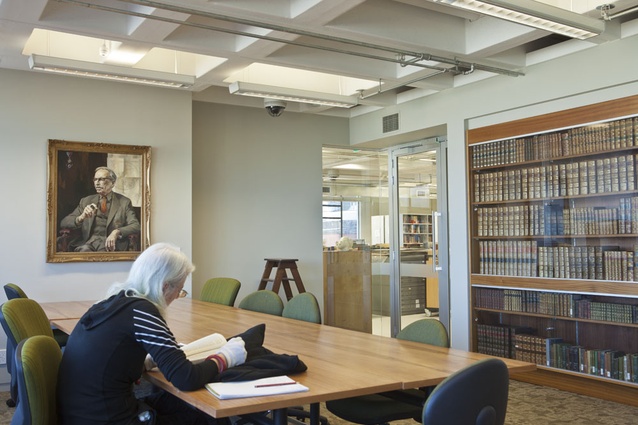Victoria University’s new hub
The new ‘hub’ of Victoria University’s Kelburn campus is designed to improve connections – the physical flow of people and their social, informational and learning exchanges.
Victoria University’s Kelburn Campus Hub in Wellington is undergoing heart surgery while the business of learning and teaching continues to pump. The intent is to improve connections – the physical flow of people, their social, informational and learning exchanges – and to ensure the university offers world-class research and study facilities.
Refurbishment of the library in seven floors of the Rankine Brown building is part of the project, and accompanies a major change in how the library will deliver its services via automated systems. “The Hub is about how students are socialising and learning now, not just within teaching rooms or lecture theatres; it’s how they learn informally in small groups,” says Satish Dahya, associate director campus development. “We did a complex staging exercise within the library – how to maintain operations and business continuity within Rankine Brown and get the work done progressively.”
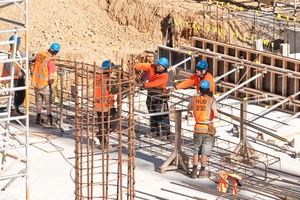 The new built spaces are designed to last a long time and be adaptable for any changes of use in the future. Students heralded the demolition phase, splashing a psychedelic ‘goodbye’ around their old walkthrough and meeting place – the covered quadrangle between Rankine Brown (library), Easterfield and Maclaurin buildings – before Mainzeal moved in to demolish the ‘quad’ and excavate the site mid-November last year. Since then a new three-level, central building (floor area 4260 sq m) has filled the space. Mainzeal is also refurbishing the library (floor area of 10,490 sq m includes Maclaurin and Easterfield buildings) and upgrading services while they work around the study rhythms of students and staff.
The new built spaces are designed to last a long time and be adaptable for any changes of use in the future. Students heralded the demolition phase, splashing a psychedelic ‘goodbye’ around their old walkthrough and meeting place – the covered quadrangle between Rankine Brown (library), Easterfield and Maclaurin buildings – before Mainzeal moved in to demolish the ‘quad’ and excavate the site mid-November last year. Since then a new three-level, central building (floor area 4260 sq m) has filled the space. Mainzeal is also refurbishing the library (floor area of 10,490 sq m includes Maclaurin and Easterfield buildings) and upgrading services while they work around the study rhythms of students and staff.
In a very live, compact site where thousands of people may circulate daily, timing is critical for client and contractor. Student numbers in 2010 were 22,310, with 1871 full-time equivalent staff employed across Victoria’s four campuses. As we climb scaffolding to level three of the growing building, Mainzeal project manager John Igglesden talks about the complexities of the site. To maintain circulation and minimise disruption, client and contractor have done intensive planning, staging and communicating.
“The main challenge is clearly the operational side of the campus,” says Igglesden. “We are right in the heart of it … working in all three surrounding buildings, so we interact with faculty members and students an awful lot more” than when Mainzeal built the university’s Alan MacDiarmid building. The quad was a major crossroads of the campus, providing access to and from the library and departments in Rankine Brown, access to and from lecture theatres and departments in the other surrounding buildings, as well as Kelburn Parade and food and retail outlets.
Movement around these areas was not ideal; the old quad had passed its use-by date, and gate five from Kelburn Parade between Maclaurin and Easterfield, was a wind and rain tunnel. The new design reclaims and makes better use of the space. To allow people to circulate during construction, a priority was to build a stairway and walkthrough between the building site and Rankine Brown, giving access to the library and Maclaurin building; another temporary walkway provides improved access to Easterfield – all of which created a ring road around the site. The surrounding buildings are roughly at the level of Kelburn Parade, so the quad area had to be excavated down to the same level before construction could start. When designing the new building Colin Russell, Athfield Architects working with Architectus, says they researched the kinds of spaces people are now learning in.
“It’s much more informal, and while there’s still a need for desks, it’s more laptop based, group based, people talking to each other – a collaborative approach.” The open-plan, simple, cellular design will suit changing needs over the next 25 years and allow the activity of people to be the focus. Level three of the new building will be a library reading room; level two is a mezzanine and the main entrance to the library; level one will provide mixed use – a socialising and events space and access to the library; a new landscaped quad will be an outdoor recreational area and gate five will become a retail centre.
The timing of construction processes is crucial so that the university may continue its business. The client and contractor have spent many hours on the details of staging. Drilling, and other potentially disruptive work, happens around lecture times where possible. To help them plan work, Igglesden receives the university’s events timetable, which covers all four campuses. “It has 4500 events on it – that was [just] a week,” says Igglesden. Mainzeal breaks down the two-year construction programme for the Kelburn campus into months and weeks and liaises with the client – micromanaging situations to control noise and site traffic around the flow of people.
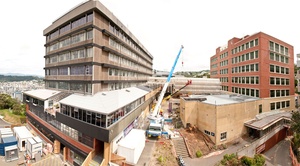
Early mornings between 5am and 8.30am are good working times. “Students don’t get up that early but they seem to work late and the library is open six and half days a week. Tradesmen get into the way of doing all drilling in the morning and fixing for the rest of the day.” In the central building a displacement ventilation system is an unusual feature of the mechanical services. Russell says they worked closely with Beca and Dunning Thornton engineering firms. Beca’s strategy is based on “some very good, simple principles,” Russell says.
Structural concrete columns encased in a polycarbonate shroud, lit at night, create ducts distributing air from the upper plant room down into the floor plenums located at the ground and the upper reading room. Air is both passively drawn and fan-assisted, down and around the columns through a false floor into the basement void. The air inside rises up through grilles and vents in the floor and is drawn out at a high level. “There is a double skin to the building that incorporates a void. When the air comes up it passes through this void and goes back through a heat-transfer system, before being discharged,” says Russell. Massive glazed doors, the largest of their kind in New Zealand Igglesden thinks, will be part of the system. On a hot day they will open automatically.
There are two sets of two doors, each 6m high by 4m wide; they will make possible a seamless physical and visual flow between the paved landscaping outside and the social space on level one. “With the glass façade there’s potential that for 30 percent of the year the building could work free of charge – a big saving for the university,” Russell says. To deal with earthquakes, and in response to the varied and complex interfaces between the new and old buildings, a uniform system was developed, which can adapt and apply to each unique condition, Russell says. The interface between Easterfield and Maclaurin, which were built between the late 1950s and 60s, is a simple sliding-plate system.
“A simple slot gap between the two just opens and closes. [The new building] is essentially a very big two-storey house.” Rankine Brown was base-isolated in 2002 and will make “a larger wobble,” in contrast to the shorter, sharper movement of the other buildings requiring a larger movement interface. Inside Rankine Brown, Igglesden opens a door into a large quiet space full of students and computers. “It’s another world. I’m impressed by the students; they’re very focused people. What we see here is the way more libraries are going – all through an electronic system. The human interaction side will be really only when you’ve got a problem.”
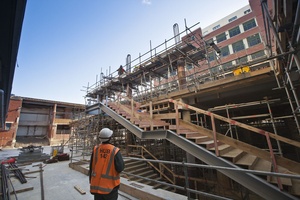
The upgrade of Rankine Brown has involved relocating the specialist JC Beaglehole Room and the post-graduate and staff restaurant, Milk and Honey. Mainzeal refurbishes the interior of the library when sections come free. “As they remove books in some areas we go in and refurbish then they come back and restock,” says Igglesden. They strip each area back to the structure and screen it off with polypanels, which they reuse until they are “munted” he says.
The upgrade includes a new layout, air conditioning and sprinklers and the lighting is converted to a Dynalight system – part of a modernised BMS. As we walk out of the Sutherland Room one of the operatives is vacuuming debris off the carpet. It’s a matter of keeping the place clean, tidy and neat and knowing where people are going to be, Igglesden says. During the summer months when fewer people will be on campus, specifically disruptive work is programmed such as service cut-ins (gas, electricity, sprinklers) when power may be out for a few days.
The university is investing $67 million in the project and by the beginning of the academic year 2013, the central building and new quad will be ready to inject a new flow of energy through the capital city’s oldest university campus.

